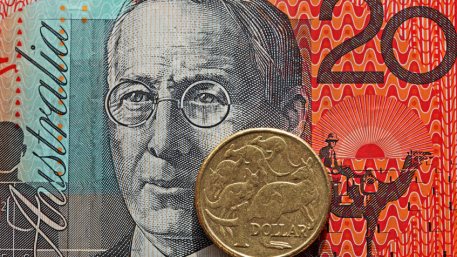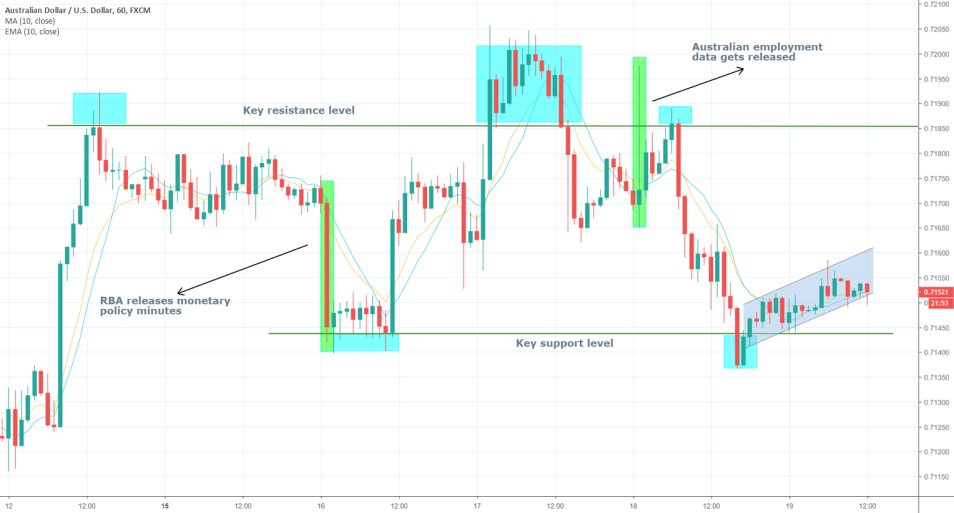
Early on Tuesday morning the Reserve Bank of Australia released its monetary policy statement, in which key economists and the chairman of the RBA Philip Lowe outlined the details concerning their decision from the second of April to keep the interest rate unchanged at 1.5 per cent.
In the statement, it was noted that even though global trade tensions are slowly easing down, "continued strength in labour market data and moderating GDP growth were sending different signals about the momentum in economic activity".
As a result of that global uncertainty, the RBA was inclined to keep the interest rates unchanged for the time being, in order to avoid unknowingly hindering the economy by making premature decisions, in this environment of this global instability.
The AUDUSD currency pair lost 0.35% of its value in the first hour after the release of the monetary policy minutes, as investors reacted to the remarks by Mr Lowe and his colleagues about the moderation of economic growth but then the aussie found strength at the support level of 0.71437 and bounced back.
From RBA’s extended statement it became evident that a key factor for the sustained economic growth in the near future would be the strength of the national labour market, which is why yesterday’s unemployment data was so highly anticipated.
Even though the overall unemployment rate remained at the previous level of 5.0% and there were no major disparities between the actual data and the initial forecast, which could have potentially shocked the market, there was some initial and sizable volatility.
A prime cause for that initial bullish spike in the AUDUSD was the better-than-expected employment rate, which was not significant enough to decrease the overall level of unemployment, but still managed to beat the initial estimations of 15.2K new jobs by adding a total of 25.7K new positions in the labour force.
As a result, the AUD/USD appreciated with 27 pips on the positive employment data but then rebounded from the significantly important resistance level at 0.71854. Now that the market has time to assimilate the fundamental data from this week, the questions arise as to whether the aussie will manage to resist the bearish pressure and remain trading within the newly formulated price range between the two aforementioned levels of support and resistance.

Trendsharks Premium
Gold is undergoing a correction, as investors take profits to offset losses from falling stock prices, impacting their margins. However, we anticipate a renewed wave of [...]
The Swiss stock market index is mirroring its global counterparts, such as Germany 40 and US100, experiencing a sharp decline following the announcement of new [...]
We’re analyzing the weekly chart to grasp the broader market trend. Over the past three years, the US30 index has surged by 17,000 points, often resembling a nearly straight [...]
Over the past week, the DAX has experienced a sharp decline, plunging by an astonishing 3,400 points. This downward movement is not isolated, as its international counterparts, such as the UK100 and US100, are also facing significant [...]
EURUSD recently formed a double top at 1.0930, signaling a potential trend reversal, and has since begun a correction. After a 600-pip rally since early March, a pullback at this stage is both expected and healthy. Given these conditions, we are placing a [...]
Since early March, EURJPY has surged nearly 1,000 pips, providing us with several excellent trading opportunities. However, as the rally matures, many early buyers are beginning to take profits, leading to a noticeable slowdown in the uptrend. On Friday, the pair formed a [...]
The AUDJPY currency pair continues to be dominated by bullish momentum, as multiple golden cross patterns reaffirm the strength of the ongoing uptrend. Despite this, we are witnessing a much-needed [...]
The EURAUD currency pair appears to be undergoing a trend reversal, signaling a potential shift in market direction. A notable technical development is the formation of a Death Cross on the chart, a widely recognized bearish indicator that typically suggests a [...]
After securing an impressive 200-pip profit last week, the EURJPY currency pair is now undergoing a southward correction, retracing some of its recent gains. Despite this temporary pullback, the Golden Cross remains intact, reinforcing our view that the overall trend continues to be [...]
The appearance of a Golden Cross in Silver strengthens our analysis that the metal is currently in a strong uptrend, indicating further bullish momentum in the market. This technical pattern, where the short-term moving average crosses above the [...]
This trade presents a considerable level of risk and can be classified as an opportunistic move based on recent price action. The GBPUSD currency pair has experienced a substantial bullish rally, surging by nearly 500 pips in a strong upward movement. However, after this extended period of appreciation, the pair is showing signs of a potential [...]
The anticipated Death Cross on the SMI20 appears to be failing as price finds strong support at the 23% Fibonacci retracement level. After testing this area, the index has shown bullish strength, printing several large green candles, signaling an increase in [...]
A Golden Cross has just appeared on the USDJPY chart, signaling a potential bullish move. This technical pattern occurs when the 20 period moving average crosses above the 60 period moving average, a widely recognized indication of increasing [...]
After 2 months of a down trend, we finally see some indications of price recovery for Oil. The golden cross, a historic buy signal, supports this [...]
For the past month, the German DAX40 has experienced a remarkable 10% surge, reflecting strong bullish momentum. Despite ongoing market volatility and frequent pullbacks, every dip continues to attract fresh buyers, reinforcing the [...]
Oil continues its downward trajectory, despite occasional pullbacks. The overall trend remains bearish, reinforced by multiple Death Cross patterns, a classic sell signal indicating further weakness. Adding to this bearish outlook, the critical [...]
Over the past few days, gold has experienced a sharp decline of more than $100. This downturn can be attributed in part to traders securing profits to manage their margins, which are under strain due to the significant drop in major indices. Currently, gold has fallen below the [...]
The NASDAQ 100 index is showing strong bullish momentum, as evidenced by the formation of a Golden Cross on the chart. This classic buy signal occurs when the short moving average crosses above the long term moving average, suggesting that upward momentum is [...]
The EURAUD currency pair has encountered a significant resistance level, failing to break above the critical 61% Fibonacci retracement level. This suggests that bullish momentum is weakening, reinforcing the case for a potential downward move. Given this technical setup, we favor entering a [...]
The UK100 is experiencing a remarkable rally! Over the past few weeks, the British stock market index has surged nearly 800 points. Each minor dip has attracted more buyers, fueling the bullish momentum. However, since last week, we’ve observed a slight [...]




















